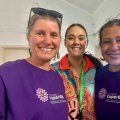
Studying “zombie snails” and discovering the Great Barrier Reef’s hidden species is all in day’s work for University of Queensland Associate Professor Tom Cribb.
The School of Chemistry and Molecular Biosciences researcher focuses on the hundreds of species visitors to the reef rarely notice: parasitic worms.
While not as pretty as the corals, molluscs and fish that attract tourists, Dr Cribb said if the trematodes, or “flukes”, he studied were to disappear from the Great Barrier Reef, it would vastly change the way the reef operated.
“Although the average visitor to the reef will never see them, these parasites are in almost every fish, bird, dolphin and turtle that is seen in the area. As such they are an important part of the hidden biodiversity of the reef,” he said.
“There are far more species of parasites than the birds, fishes, reptiles and mammals that harbour them on the reef, so if we ignore them we ignore a lot of the richness of the system.”
Dr Cribb said the flukes usually did their hosts little harm, but for some hosts, infection could have dire consequences.
“When a trematode infects a snail, it usually sterilises the snail for life,” he said.
“The snail looks and behaves normally but it is really just reproducing parasites instead of snails – this makes it a kind of zombie snail!”
Together with his students and colleagues, Dr Cribb has discovered and named more than one hundred trematode species in the Great Barrier Reef and he expects there are many more yet to be discovered.
He does most of his field research at UQ’s Heron Island Research Station, also teaching an undergraduate course at the station.
“Having Heron there means that there is a high quality station that can be visited many times to build detailed knowledge over many years,” Dr Cribb said.
“Most students say – no surprise really – that it is just about the best experience of their undergraduate life.
“And it is not just fun. It really is not possible to beat the combining theory with field and directly related laboratory work.”
Media: Dr Cribb (07 3365 2581 or t.cribb@uq.edu.au) or Tegan Taylor at UQ Communications (07 3365 2659)
.jpg)



